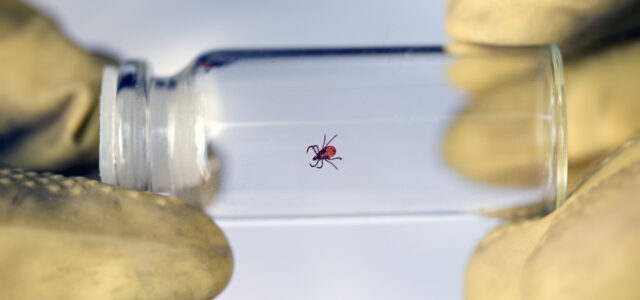Call for your appointment today 914-666-4665 | Mt. Kisco, New York

“Xenodiagnosis was positive for B. burgdorferi DNA in a patient with erythema migrans early during therapy and in a patient with PTLDS [post-treatment Lyme disease syndrome],” writes Marques from the National Institute of Allergy and Infectious Diseases at the National Institutes of Health. [1] However, there wasn’t enough evidence to conclude that viable spirochetes were present in either patient.
Researchers have allowed ticks to feed on animals while conducting animal studies. “Xenodiagnosis has long been used in Lyme disease research to provide definitive evidence of a host’s infection status,” explains Turk and colleagues in a recently published paper, Xenodiagnosis Using Ixodes scapularis Larval Ticks in Humans. [2]
But Marques’ endeavor was the “first clinical study of the use of I. scapularis larva for the xenodiagnosis of B. burgdorferi infection in humans.”
How to get a tick to bite a human for this test was described in the journal Methods of Molecular Biology. [2] The larva ticks were uninfected. “Specific pathogen-free I. scapularis larval ticks were obtained from Dr. Sam Telford from a laboratory-maintained tick colony at Tufts Veterinary School,” Turk states.
The ticks were free of B. burgdorferi, Babesia spp., Anaplasma phagocytophilum, Borrelia miyamotoi, Bartonella spp., Rickettsia spp., deer tick virus, orbiviruses Francisella tularensis, Babesia spp., Borrelia spp., Spirochetes, Rickettsia spp., and alphaproteobacteria.
[bctt tweet=”Ticks feed on humans to help diagnose #Lyme disease. ” username=”DrDanielCameron”]
The larval ticks were applied to the subject using a wooden toothpick. “If any tick escapes from the placement site or vial during the process,” Turk states, “a piece of adhesive tape can be used to rapidly capture the tick.” An adhesive liner held the ticks in place.
The subject was sent home with specific instructions on how to care for the site where the tick attached.
- Your dressing is to remain in place for 4–6 days. The dressing keeps the ticks in place. Please do not open or remove the dressing during the study period.
- Do not scratch the dressing site if it itches. You may take oral diphenhydramine (Benadryl) for itching.
- When showering, please cover the dressing site with AquaGuard. Remove the AquaGuard promptly after showering. Gently pat dry the dressing if necessary.
- Please check that the dressing is firmly in place.
- Refrain from aerobic exercise or any activity that would induce heavy perspiration.
- Check the dressing daily to make sure all edges are sealed. Call the study personnel if there is a problem with the dressing.
Not to worry if you lose a tick, writes the author. “Loss of ticks should not pose a risk to either the participant or other people in contact with the subject.” [2] He elaborates, explaining:
“Ixodes ticks require high moisture content and would not survive in an indoor or urban setting for more than 1 or 2 days.”
“Unfed ticks would be uninfected and at most, would attach at a site other than the xenodiagnostic site on the participant or, perhaps, on a family member.”
“Fed ticks are not expected to feed again for 3 – 6 months.”
The authors point out that “Xenodiagnosis using Ixodes ticks in humans remains an experimental method and must be performed under an approved clinical research protocol.”
Related articles:
You can’t count on testing of engorged ticks
Study demonstrates further evidence larval ticks may be a threat to humans
Tracking ticks in Canada with digital images
References:
- Marques, A., et al., Xenodiagnosis to detect Borrelia burgdorferi infection: a first-in-human study. Clin Infect Dis, 2014. 58(7): p. 937-45.
- Turk, S.P., C. Williams, and A. Marques, Xenodiagnosis Using Ixodes scapularis Larval Ticks in Humans. Methods Mol Biol, 2018. 1690: p. 337-346.




My understanding is that tick attachment induces some previously present borrelia spirochetes to migrate to the attachment site. Has anyone considered using uninfected lab ticks to increase tissue PCR yield?
I am not familiar with the migration of spirochetes. There can be an more aggressive immune response if there was a previous infection. I am not not all that thrilled letting ticks bite you as part of the diagnostic test.
“However, there wasn’t enough evidence to conclude that viable spirochetes were present in either patient.” How is it possible to say that? It is totally illogical. If the tick got Lyme, then the Lyme bacteria can only have come from the patient.
The authors were hedging. They implied that the spirochetes may not be viable if transmitted to another person. But who would want to place the infected tick on another person.